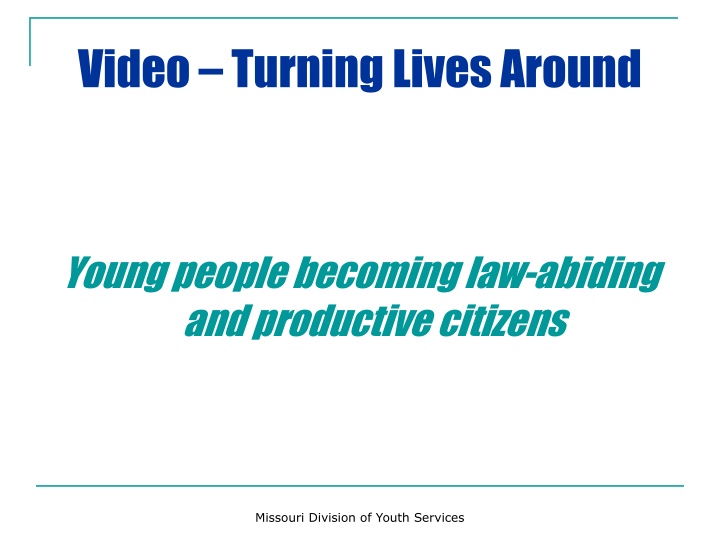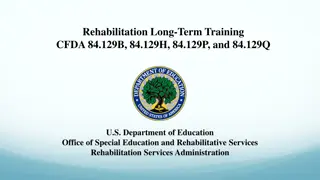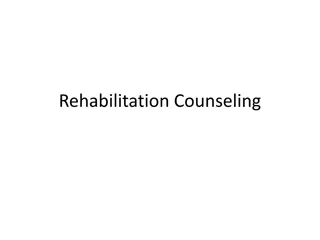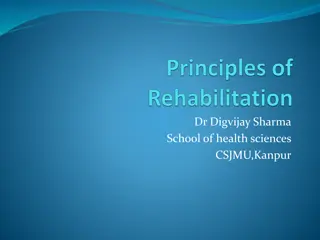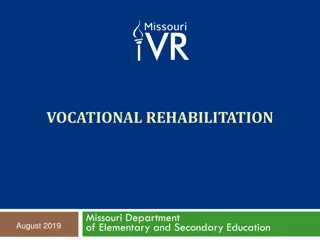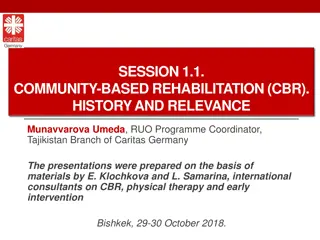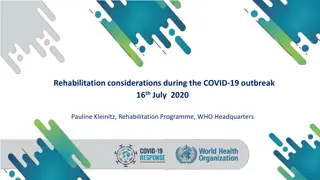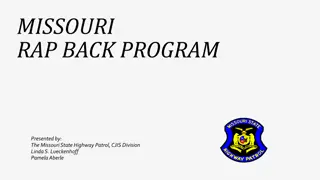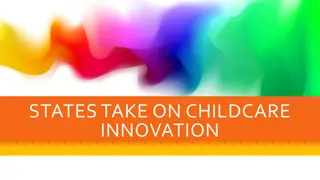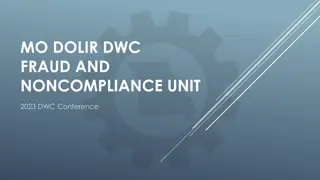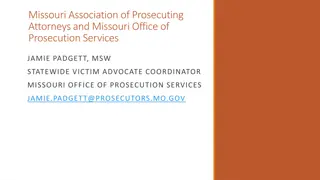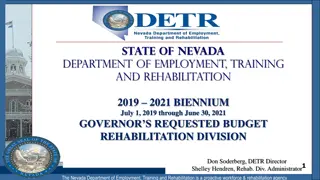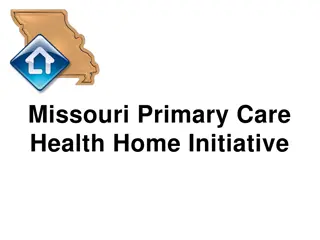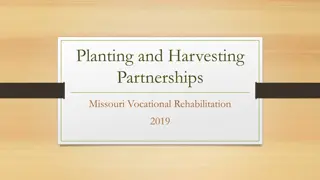Innovative Approaches to Youth Rehabilitation in Missouri
This comprehensive document sheds light on the transformative initiatives undertaken by the Missouri Division of Youth Services to guide young individuals towards a law-abiding and productive path. It explores contrasting correctional/traditional methods with treatment/developmental approaches, emphasizing the significance of communication, positive regard, boundaries, and a supportive environment in reshaping behavior and fostering change in youth. Additionally, it delves into the principles of integrated treatment, cognitive-behavioral strategies, and holistic approaches in addressing behavioral issues within a familial and community context.
Download Presentation

Please find below an Image/Link to download the presentation.
The content on the website is provided AS IS for your information and personal use only. It may not be sold, licensed, or shared on other websites without obtaining consent from the author.If you encounter any issues during the download, it is possible that the publisher has removed the file from their server.
You are allowed to download the files provided on this website for personal or commercial use, subject to the condition that they are used lawfully. All files are the property of their respective owners.
The content on the website is provided AS IS for your information and personal use only. It may not be sold, licensed, or shared on other websites without obtaining consent from the author.
E N D
Presentation Transcript
Video Turning Lives Around Young people becoming law-abiding and productive citizens Missouri Division of Youth Services
Correctional/Traditional COMPLIANCE Autocratic Leadership., Regiment Autocratic Leadership, Regiment VUNERABILITY = WEAKNESS YOUTH ARE TREATED THE SAME AS ADULTS Shame Based Rigid rules change behavior Youth Are Inmates FEELINGS FEELINGS ARE ARE IGNORED IGNORED punishment FEAR Coercive or Positional Power, External Controls, Survival Unexamined Assumptions Gail D. Mumford & Phyllis Becker
Treatment/Developmental CHANGE Group Process, Leadership Group Process, Leadership Self Healing Hope Corrective Experiences Accountability Disclosure Empathy Empathy Natural Logical ConsequencesConnectedness Self Conscious Choice Expression Discovery Connectedness SAFETY Basic expectations, supervision, healthy hierarchy, boundaries, unconditional positive regard Beliefs, Philosophies
Mo.DYS Executive Leadership Team January 2009 Boundaries & Communication Boundaries & Communication Clear, caring, firm boundaries Staff walk the talk Warm welcome (orientation) Trust building (foundation for safe self disclosure) Unconditional Positive Regard Unconditional Positive Regard Dignity & respect Strengths-based Equity, hope Basic Needs Met Basic Needs Met Food, clothing, shelter Emotional & physical safety Humane environment Belonging (you are not alone) Family involvement Supervision Supervision Awareness (Eyes, Ears, Hearts) Predictability, structure, balance Basic Expectations Basic Expectations How we treat each other and our environment (no hurting) Clean, neat, & orderly Rights & Responsibilities BELIEFS & PHILOSOPHIES BELIEFS & PHILOSOPHIES Missouri Division of Youth Services
Approaches to Reshaping Behavior Integrated Treatment Approach Cognitive Behavioral Punitive Penalizing Educational Holistic Behavioral, Cognitive, Emotional Family Systems Group Process Experiential Community Missouri Division of Youth Services
Reshaping Behavior: Completing the Puzzle Change Process Internalized Change Compliance IMPACT Negative Control Loop Conformity/ Submission Integrated TX Behavioral, Cognitive, Emotional, Family Systems, Youth Development, and Community Integration Punitive Behavioral/Cognitive Educational Missouri Division of Youth Services APPROACH
DYS Performance Measures Law-Abiding Behavior 3 years after discharge 93% of DYS youth have avoided further incarceration, and 67% have avoided further involvement with juvenile justice or adult corrections. Productive Involvement Over 86% of DYS youth are productively involved in their communities through school or work. Source: Missouri Department of Social Service, Center for Management Information Missouri Division of Youth Services
DYS Performance Measures Educational Progress and Completion - progressing toward college or a career: 80% earn high school credits, compared to 50% nationally. 30% earn a GED or HS Diploma, compared to 11% nationally. 40% successfully return to their local school district, compared to 20% nationally. 87% improved in reading and math, compared to 72% nationally. 70% improve at a faster rate than their same-age peers in core subjects. Source: U.S Department of Education, Title I, Part D Annual Program Performance Report, 2007-08 School Year Missouri Division of Youth Services
Mo.DYS Educational Completion at Age 17 50.00% 44.19% 45.00% 38.14% 40.00% 35.65% 35.00% 30.86% 30.00% 27.25% 24.53% 24.46% 23.48% 25.00% 20.00% 15.00% 10.00% 5.00% 0.00% FY04 FY05 FY06 FY07 FY08 FY09 FY10 FY11 Missouri Division of Youth Services
DYS Performance Measures Safe and Humane Environments Youth are 4 times more likely to be assaulted in other youth correctional programs than in Missouri DYS. Staff members are 13 times more likely to be assaulted in other youth correctional programs than in Missouri DYS. Source: Research by Dick Mendel (2008) comparing Missouri DYS to youth correctional programs participating in the Performance Based Standards (PbS) process. Missouri Division of Youth Services
Strengthening Youth Transitions neighborhood school youth family Missouri Division of Youth Services
National customs Cultural values Mass Media Social conditions Economic patterns Political philosophy Intimate & Immediate Effects: Family, School, Peers, Religious Institutions Young Person Extended Family, Work, Neighbors and Friends of the Family, Mental Health and Social Service Agencies Bronfenbrenner s Ecological Model of Development
Service/Program Silos to Community Resource System Family Support Service Coordination Day Treatment Non- Residential Continuum of Care Community Care Community Partnerships
A Broader Vision Moving from Programs to Systems Layers of support for youth and families, building social capital Comprehensive wraparound services across agencies and systems Youth and family-driven services (e.g. youth centered transition planning) Mobilization of natural helping networks (e.g. state services comprise no more than 50% of treatment plan)
A Broader Vision Moving from Programs to Systems Comprehensive family engagement and support (e.g. resource centers, multi-family groups, volunteer opportunities/reciprocity, health/wellness, emergency assistance) Integration with Family Courts and Juvenile Court Diversion Youth development opportunities (e.g. youth boards/leadership, afterschool activities, productive involvement) Post-secondary, vocational, and career services for youth and families
Contacting Missouri Division of Youth Services: Tim.Decker@dss.mo.gov www.dss.mo.gov/dys www.missouriapproach.org (573) 751-3324 Missouri Division of Youth Services
